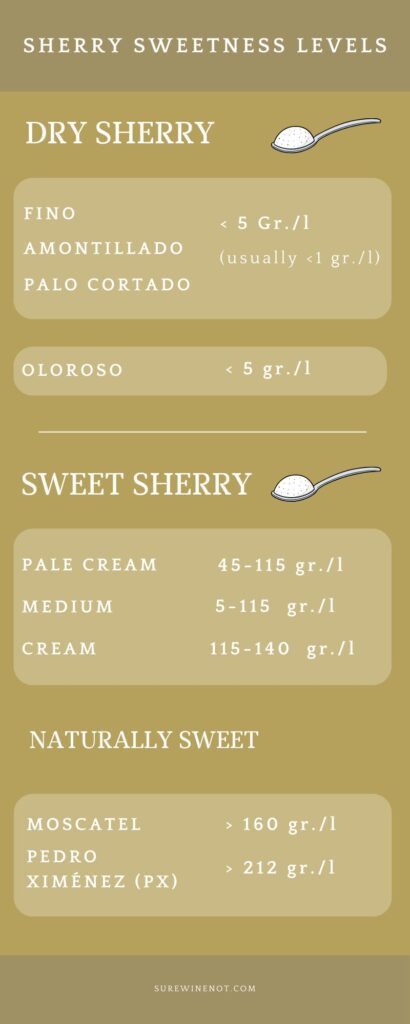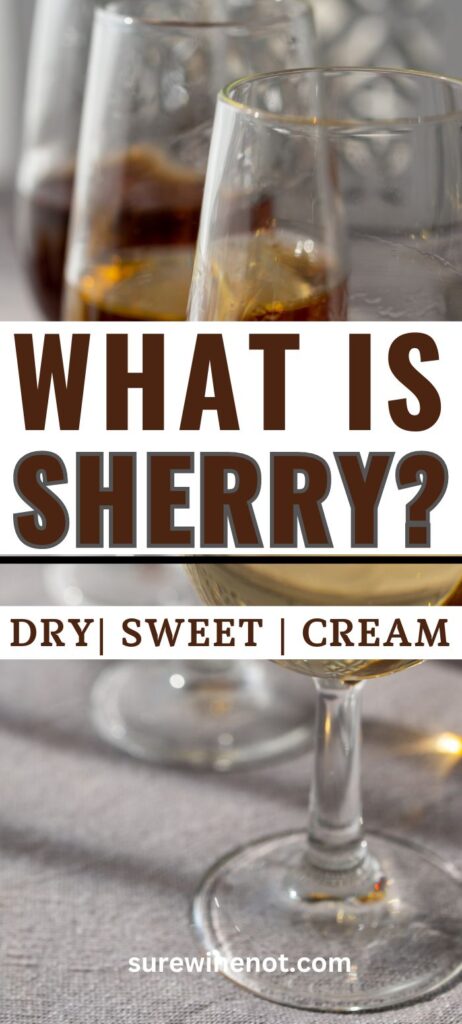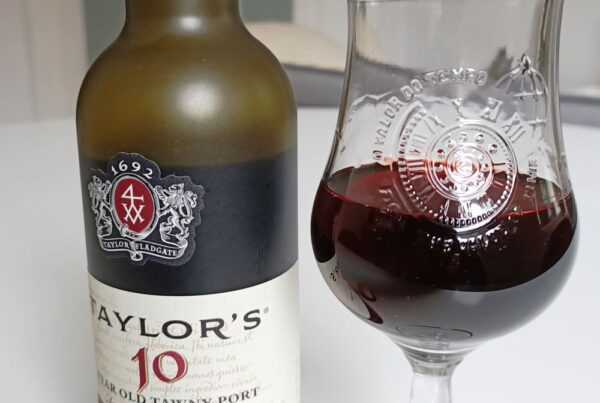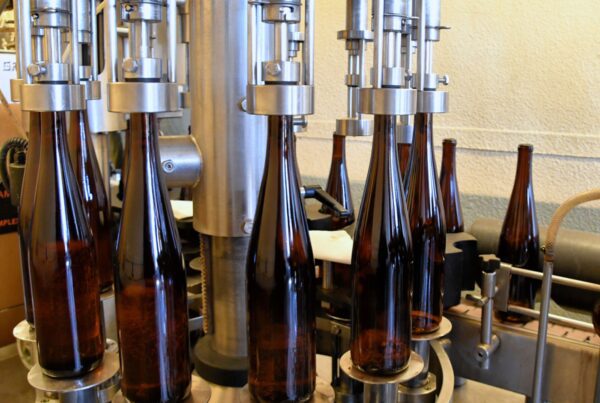Sherry is a delicious drink that makes for a great aperitif or dessert wine at almost any gathering.
It can also be mixed with all kinds of other ingredients to make delicious cocktails. If you’re wondering if Sherry is sweet or dry, you’ve come to the right place!
Sherry wine is made in both dry and sweet styles. It is made in all levels of sweetness from bone dry to lusciously sweet and everything in between.
Dry Sherry
- Fino
- Manzanilla
- Amontillado
- Oloroso
- Palo Cortado
Sweet Sherry
Sweet Sherries are sweetened in two ways – naturally through the use of sun-dried grapes or through the addition of a syrupy liquid called Rectified Concentrated Grape Must (RCGM).
- Pale Cream
- Medium
- Cream
- Moscatel
- Pedro Ximenez (PX)

Contents
What is Sherry?
Sherry is a fortified wine, meaning a base wine that has a 95% abv neutral spirit added to it. This increases the alcohol content of the wine.
The fortified wine is then aged in the solera system.
Sherry wine must be made in Jerez, Spain and adhere to the Jerez DO standards (rules and regulations) in order to be labelled Sherry.

Sherry sweetness levels
| Name | Style | Sugar gr/liter (l) |
| Fino | Dry | < 5 gr./l (usually <1 gr./l) |
| Manzanilla | Dry | < 5 gr./l (usually <1 gr./l) |
| Amontillado | Dry | < 5 gr./l (usually <1 gr./l) |
| Oloroso | Dry | < 5 gr./l |
| Palo Cortado | Dry | < 5 gr./l (usually <1 gr./l) |
| Pale Cream | Sweet | 45-115 gr./l |
| Medium | Sweet | 5-115 gr./l |
| Cream | Sweet | 115-140 gr./l |
| Moscatel | Naturally Sweet | > 160 gr./l |
| Pedro Ximénez (PX) | Naturally Sweet | > 212 gr./l |
Sweetness levels in Sherry wine are determined by the Consejo Regulador as follows:
Dry Sherry sweetness levels
Dry Sherry wines have a maximum residual sugar quantity of five grams per liter.
Wines that fall under this category are Fino, Manzanilla, Amontillado, Oloroso and Palo Cortado.
Sweet Sherry sweetness levels
Sweet Sherry wines made from the traditional practice of “cabeceo”, meaning the blending of dry Sherry wines with naturally sweetened wines (e.g., PX), or in some cases with RCGM.
These wines have different levels of sweetness, but always with a sugar content that is more than five grams per liter.
Wines that fall under this category are Pale Cream, Medium and Cream.
Naturally Sweet Sherry sweetness levels
Naturally sweet Sherry wines are made using sun-dried grapes. Drying the grapes concentrates the sugar levels producing sweet wines.
The base wine for these wines is only partially fermented, leaving many of the sugars in the sweet sun-dried grape juice unconverted into alcohol.
These naturally sweet wines are very sweet.
Moscatel wine has at least 160 gr./liter.
Pedro Ximénez (PX) wine has at least 212 gr./liter.
The different styles of Sherry
There are ten different types of Sherry and they come in a variety of colors, aromas, flavors and sweetness levels.
So, let’s go through the characteristics of each type of Sherry.
Manzanilla
Manzanilla Sherry is a dry white wine. It is made with Palomino grapes and aged biologically under a veil of flor for a minimum of 2 years. Manzanilla is exclusively made in wineries in Sanlúcar de Barrameda.
Manzanilla de Sanlúcar de Barrameda is its own DO separate to the Jerez DO.
The cool and humid climate in Sanlúcar de Barrameda creates a thick layer of flor that create intense unique flavors.
The main characteristics of Manzanilla are its pale lemon color.
It is dry and fresh on the palate with aromas of citrus, floral and almonds. There are also bready notes created from the veil of flor and it has a slight bitter aftertaste.
Manzanilla is bottled ready to drink and does not benefit from ageing.
Serve chilled 6-8°C (43-46°F) in a white wine glass.
Fino
Fino is a dry white wine made from Palomino grapes.
It is made in the same way as Manzanilla, meaning that it is biologically aged under a veil of flor; however, it is made in the bodegas of Jerez de la Frontera and El Puerto de Santa María where there is a slightly different climate to Sanlúcar de Barrameda.
Fino ranges from pale lemon to gold in color with aromas of citrus fruit, almonds, herbs and bready notes.
Fino is bottled ready to drink and does not benefit from ageing.
Serve chilled 6-8°C (43-46°F) in a white wine glass.
Amontillado
Amontillado is a dry white wine made from Palomino grapes.
It is unique in that it undergoes both biological and oxidative ageing.
It is initially aged biologically under a veil of flor. When the flor dies off, the wine is then refortified to 17% abv. It is then aged oxidatively in an Amontillado solera system.
These wines are amber or brown in color with intense aromas and flavors of hazelnuts, herbs and tobacco.
Serve lightly chilled 12-14°C (54-57°F) in a white wine glass.
Amontillado is bottled ready to drink and does not benefit from ageing.

Oloroso
Oloroso is a dry white wine made from Palomino grapes.
It is an oxidatively aged wine. Oloroso ranges from amber to deep mahogany in color. The longer it is aged, the darker the color becomes.
It is smooth, full-bodied and has oxidative aromas of walnuts, toffee, leather and spices.
Serve lightly chilled 12-14°C (54-57°F) in a white wine glass.
Oloroso is bottled ready to drink and does not benefit from ageing.
Palo Cortado
Palo Cortado is a dry white wine made from Palomino grapes.
Similar to Amontillado it undergoes both biological and oxidative ageing.
These are wines produced from very fine must and initially are fortified to 15%. The casks are marked with a “palo,” or slash.
Palo Cortado is a rare type of Sherry. After sobretabla, if the winemaker notes the existence of certain characteristics in some of the casks with a veil of flor, they will mark it as a potential Palo Cortado by drawing a horizontal line across the original slash mark.
The wine is refortified to above 17% and then goes into an oxidative ageing solera system.
Palo Cortado ranges from chestnut to mahogany in color. It has similar aromas to Amontillado and the body and palate of Oloroso.
Palo Cortado is bottled ready to drink and does not benefit from ageing.
Serve lightly chilled 12-14°C (54-57°F) in a white wine glass.
Pale Cream
Pale Cream is a sweet white wine made from Palomino grapes.
It ranges from lemon to pale gold in color and with hazelnut and bready aromas.
Pale Cream is usually sweetened with RCGM.
Serve chilled 7-9°C (45-48°F) in a white wine glass.
Pale Cream is bottled ready to drink and does not benefit from ageing.
Medium
Medium Sherry is a medium sweet white wine made from Palomino grapes.
It is in essence an Amontillado Sherry with PX added. The PX sweetens the wine.
It ranges from amber to brown in color with walnut, toffee, leather and bready notes.
Serve lightly chilled 12-14°C (54-57°F) in a white wine glass.
Medium Sherry is bottled ready to drink and does not benefit from ageing.
Cream
Cream Sherry is a sweet white wine made from Palomino grapes.
It is known as Sweet Oloroso because it is, in essence an Oloroso with PX added for sweetness.
It ranges from light to dark brown in color with oxidative aromas of roasted nuts and caramel.
Serve lightly chilled 10-12°C (50-53°F) in a white wine glass.
Cream Sherry is bottled ready to drink and does not benefit from ageing.
Moscatel
Moscatel is a sweet white wine made from sun-dried Moscatel/Muscat of Alexandria grapes.
It ranges from brown to deep brown in color with citrus, floral, dried fruit and coffee aromas and flavors.
Serve lightly chilled 12-14°C (54-57°F) in a white wine glass.
Moscatel is bottled ready to drink and does not benefit from ageing.
Pedro Ximénez (PX)
Pedro Ximénez is a sweet white wine made from sun-dried Pedro Ximénez grapes. It is the sweetest of all Sherries.
PX is oxidatively aged and deep brown in color with dried fruit, honey, coffee and chocolate notes.
Serve lightly chilled 12-14°C (54-57°F) in a white wine glass.
Pedro Ximénez is bottled ready to drink and does not benefit from ageing.
How Sherry is made
Grapes
Sherry is made from Palomino, Pedro Ximénez and Moscatel/Muscat of Alexandria grapes (all white grapes).
Dry Sherry wines are primarily made from the Palomino grape and naturally sweet Sherries are made using sun-dried Pedro Ximénez and Moscatel/Muscat of Alexandria.
Palomino and Pedro Ximénez grapes are neutral-flavored grapes which makes them ideal for Sherry production where the flavors develop during the ageing process.
Base Wine
At the winery, Palomino grapes are destemmed, crushed and fermented into a dry base wine.
Pedro Ximénez and Moscatel grapes are sun-dried, and then made into a sweet wine.
A veil of flor
A layer of “flor”, a type of yeast, forms a film over the top of the wine.
The yeast feeds off of the alcohol, other nutrients and oxygen in the barrel. The flor produces carbon dioxide and acetaldehyde. The acetaldehyde gives Sherry its distinctive flavor.
First Classification
At this point, the winemaker classifies the wine into two types – wines that will be aged biologically and wine that will be aged oxidatively.
How the wine is classified will greatly impact how it will look and taste.
Fortification
The wine is fortified with a neutral spirit. Wines for biological ageing are fortified to between 15-15.5%. This level of fortification is ideal for the continued development of flor.
Wines for oxidative ageing are fortified to 17%. Flor cannot grow at this strength and die off.
Sobretabla
The wine is set aside for a few months after fortification before being matured in the famous Sherry solera system. This period is called “sobretabla”.
Biologically aged wine
Biologically aged Sherry, such as Fino, Manzanilla and Pale Cream, continue ageing under the film-forming yeast flor.
The wine is matured in large 600-liter American oak wooden barrels called “butts” or “bodega butts”.
Each barrel is filled to 500 liters leaving, 100 liters of oxygen. The oxygen ensures the flor can continue to feed and form a layer over the wine. The flor protects the wine from oxygen in the barrel.
The pale-yellow color of the wine is preserved and the wine develops unique flavors and aromas from the yeast.
Oxidatively aged wine
Oloroso, Pedro Ximénez (PX) and Moscato are aged oxidatively. Amontillado and Palo Cortado are both aged oxidatively after biological ageing.
When the wine is fortified to 17%, the flor dies off. The contact with oxygen causes the wine to become deeper in color and to develop complex aromas and flavors.
The Solera System
Sherry wine is matured in a system called the “solera system” or the criaderas and solera system.
It is a system where wines of various maturation levels are mixed together to maintain consistency and particular qualities in the wine. This involves blending wines from different vintages to create a particular style or flavor.
The blending process is very specific and somewhat complex, so I will try to describe it in simple terms.
Butts are grouped together into levels that are known as “criaderas”. Each criadera contains wine of different average ages.
The number of levels in the system can vary, but the wines with the oldest average is the bottom level and the top level is wine that has come from the sobretabla.
When the wine in the criadera on the bottom level is ready for bottling, an equal amount of wine is taken from each butt. It is then blended together and bottled.
The bottom criadera is only ever partially emptied and the wine is replenished by drawing the same amount of wine from the criadera on the next level up.
The wine from each butt from this level is also blended together before replenishing the bottom criadera. The replenishment continues through each level until you get to the top level, which is replenished from the sobretabla.
How much alcohol is in Sherry?
The table below outlines the different types of sherry and typical alcohol by volume (ABV) percentages.
Please note that the ABV for Sherry can vary within the ranges. So, check the label for an exact ABV.
| Type of Sherry | Alcohol by Volume (ABV) |
| Fino | 15-18% (usually 15%) |
| Manzanilla | 15-19% (usually 15%) |
| Amontillado | 16-22% |
| Oloroso | 17-22% |
| Palo Cortado | 17-22% |
| Pale Cream | 15.5-22% |
| Medium | 15-22% |
| Cream | 15.5-22% |
| Pedro Ximénez (PX) | 15-22% |
| Moscatel | 15-22% |
FAQ
What Sherry is the sweetest?
Pedro Ximénez (PX) Sherry is the sweetest of all Sherries having a minimum of 212 gr./liter.
Is Cream Sherry always sweet?
Yes, Cream Sherry is a sweet Sherry that has between 115-140 gr./liter. Cream Sherry is, in essence, an Oloroso Sherry that has a naturally sweet wine, Pedro Ximénez (PX), added to it.
What is the difference between Sherry and fortified wine?
Sherry is a type of fortified wine, but not all fortified wine is Sherry; for example, Port wine is a fortified wine from Portugal. For a fortified wine to be called Sherry, it must come from Jerez in Spain and be made according to strict standards.






